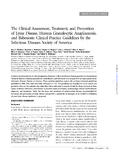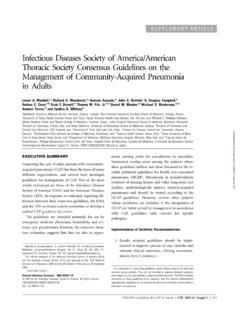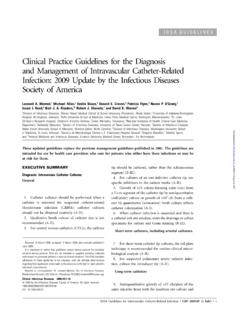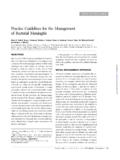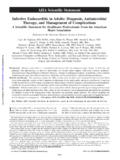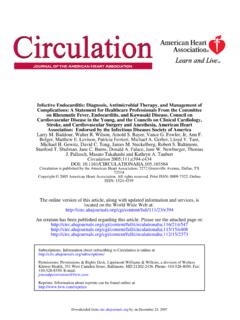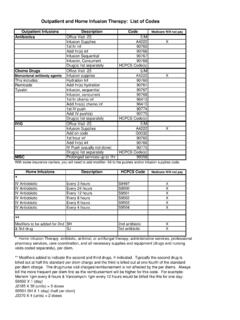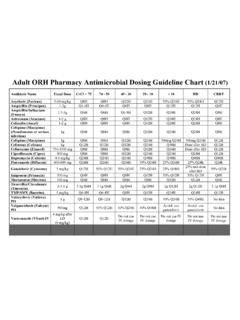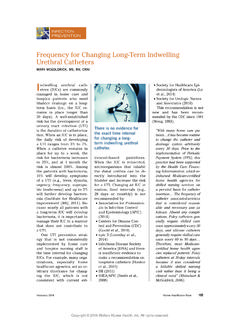Transcription of Clinical Practice Guidelines by the Infectious …
1 IDSA GUIDELINESC linical Practice Guidelines by the InfectiousDiseases society of america for the Treatment ofMethicillin-ResistantStaphylococcus AureusInfections in Adults and ChildrenCatherine Liu,1 Arnold Bayer,3,5 Sara E. Cosgrove,6 Robert S. Daum,7 Scott K. Fridkin,8 Rachel J. Gorwitz,9 Sheldon L. Kaplan,10 Adolf W. Karchmer,11 Donald P. Levine,12 Barbara E. Murray,14 Michael J. Rybak,12,13 DavidA. Talan,4,5and Henry F. Chambers1,21 Department of Medicine, Division of Infectious Diseases, University of California-San Francisco, San Francisco, California;2 Division of Infectious Diseases,San Francisco General Hospital, San Francisco, CA,3 Division of Infectious Diseases, Harbor-UCLA Medical Center, Torrance, CA,4 Divisions of EmergencyMedicine and Infectious Diseases, Olive View-UCLA Medical Center, Sylmar, CA;5 Department of Medicine, David Geffen School of Medicine at Universityof California Los Angeles.
2 6 Division of Infectious Diseases, Johns Hopkins Medical Institutions, Baltimore, Maryland;7 Department of Pediatrics, Sectionof Infectious Diseases, University of Chicago, Chicago, Illinois;8,9 Division of Healthcare Quality Promotion, Center for Emerging and Zoonotic InfectiousDiseases, Centers for disease Control and Prevention, Atlanta, Georgia;10 Department of Pediatrics, Section of Infectious Diseases, Baylor College ofMedicine, Houston, Texas;11 Division of Infectious Diseases, Beth Israel Deaconess Medicine Center, Harvard Medical School, Boston, Massachusetts;12 Department of Medicine, Division of Infectious Diseases, Wayne State University, Detroit Receiving Hospital and University Health Center, Detroit,Michigan;13 Deparment of Pharmacy Practice , Wayne State University, Detroit Michigan.
3 And14 Division of Infectious Diseases and Center for the Study ofEmerging and Re-emerging Pathogens, University of Texas Medical School, Houston, TexasEvidence-based Guidelines for the management of patients with methicillin-resistantStaphylococcus aureus(MRSA) infections were prepared by an Expert Panel of the Infectious Diseases society of america (IDSA). Theguidelines are intended for use by health care providers who care for adult and pediatric patients with MRSA infections. The Guidelines discuss the management of a variety of Clinical syndromes associated with MRSA disease , including skin and soft tissue infections (SSTI), bacteremia and endocarditis, pneumonia, bone andjoint infections, and central nervous system (CNS) infections.
4 Recommendations are provided regardingvancomycin dosing and monitoring, management of infections due to MRSA strains with reduced susceptibilityto vancomycin, and vancomycin treatment SUMMARYMRSA is a significant cause of both health care associatedand community-associated infections. This documentconstitutes the first Guidelines of the IDSA on the treat-ment of MRSA infections. The primary objective of theseguidelines is to provide recommendations on the man-agement of some of the most common Clinical syndromesencountered by adult and pediatric clinicians who care forpatients with MRSA infections.
5 The Guidelines addressissues related to the use of vancomycin therapy in thetreatment of MRSA infections, including dosing andmonitoring, current limitations of susceptibility testing,and the use of alternate therapies for those patients withvancomycin treatment failure and infection due to strainswith reduced susceptibility to vancomycin. The guidelinesdo not discuss active surveillance testing or otherMRSA infection prevention strategies in health care set-tings, which are addressed in previously publishedguidelines [1, 2]. Each section of the Guidelines beginsReceived 28 October 2010; accepted 17 November is important to realize that Guidelines cannot always account for individualvariation among patients.
6 They are not intended to supplant physician judgmentwith respect to particular patients or special Clinical situations. The IDSA considersadherence to these Guidelines to be voluntary, with the ultimate determinationregarding their application to be made by the physician in the light of eachpatient's individual : Catherine Liu, MD, Dept of Medicine, Div of InfectiousDiseases, University of California San Francisco, San Francisco, California, Infectious Diseases 2011;1 38 The Author 2011. Published by Oxford University Press on behalf of theInfectious Diseases society of america .
7 All rights reserved. For Permissions,please Practice GuidelinesdCID 2011:52 (1 February)d1 Clinical Infectious Diseases Advance Access published January 4, 2011 at IDSA on August 14, from with a specific Clinical question and is followed by numberedrecommendations and a summaryof the most-relevant evidencein support of the recommendations. Areas of controversy inwhichdataarelimitedorconflictingandwhe readditionalre-search is needed are indicated throughout the document and arehighlighted in the ResearchGaps section. The key recom-mendations are summarized below in the Executive Summary;each topic is discussed in greaterdetail within the main body ofthe note that specific recommendations on vancomycindosing and monitoring are not discussed in the sections for eachclinical syndrome but are collectively addressed in detail inSection What is the management of skin and soft-tissue infections(SSTIs) in the era of community-associated MRSA (CA-MRSA)?
8 SSTIs1. For a cutaneous abscess, incision and drainage is theprimary treatment(A-II).For simple abscesses or boils,incision and drainage alone is likely to be adequate, butadditional data are needed to further define the role ofantibiotics, if any, in this Antibiotic therapy is recommended for abscessesassociated with the following conditions: severe or extensivedisease (eg, involving multiple sites of infection) or rapidprogression in presence of associated cellulitis, signs andsymptoms of systemic illness, associated comorbidities orimmunosuppression, extremes of age, abscess in an areadifficult to drain (eg, face, hand, and genitalia), associatedseptic phlebitis, and lack of response to incision and drainagealone(A-III).
9 3. For outpatients with purulent cellulitis (eg, cellulitisassociated with purulent drainage or exudate in the absence ofa drainable abscess), empirical therapy for CA-MRSA isrecommended pending culture results. Empirical therapy forinfection due tob-hemolytic streptococci is likely to beunnecessary(A-II). Five to 10 days of therapy is recom-mended but should be individualized on the basis of thepatient s Clinical For outpatients with nonpurulent cellulitis (eg, cellulitiswith no purulent drainage or exudate and no associatedabscess), empirical therapy for infection due tob-hemolyticstreptococci is recommended(A-II).
10 The role of CA-MRSA isunknown. Empirical coverage for CA-MRSA is recommendedin patients who do not respond tob-lactam therapy and may beconsidered in those with systemic toxicity. Five to 10 days oftherapy is recommended but should be individualized on thebasis of the patient s Clinical For empirical coverage of CA-MRSA in outpatients withSSTI, oral antibiotic options include the following: clindamycin(A-II), trimethoprim-sulfamethoxazole (TMP-SMX)(A-II),a tetracycline (doxycycline or minocycline)(A-II), and linezolid(A-II). If coverage for bothb-hemolytic streptococci andCA-MRSA is desired, options include the following:clindamycin alone(A-II)or TMP-SMX or a tetracycline incombination with ab-lactam (eg, amoxicillin)(A-II)or linezolidalone(A-II).
